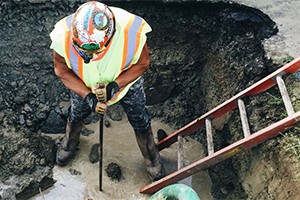In 2011, former three-term mayor of New York, Michael Bloomberg, launched a $20+M initiative through Bloomberg Philanthropies whose goal was to give cities the financial capability to spark, attract, and cultivate innovation. Syracuse, NY became one of those cities in the fall of 2014.

Sam Edelstein
The awarding of this Bloomberg Grant to Syracuse entailed the use of the funds as support for government innovation. To that end, Syracuse created an Innovation Department – a team of people motivated to rethink issues and find creative and relevant answers to the city’s most prevalent problems.
Just last month, Sam Edelstein, a Syracuse University graduate and current iSchool student, pursuing his master’s degree in information management, as well as a certificate in data science, became the city’s first Chief Data Officer. Since Sam joined the Innovation team in 2015, he “kept pushing for the position to be created – someone overseeing [data collection] and working with all departments, able to infer across areas where data is stored,” Sam told me in an interview earlier this month.
The Innovation Department was made “to infiltrate city government and find real solutions to problems that have been hampering the city for a period of time.” Data aggregation and analysis is integral to that process.
A month into his role, Sam and the rest of the Innovation team follow a model from Bloomberg to spur innovation: 1) research; 2) idea creation; 3) forming manageable projects out of those ideas; and 4) assigning projects to accountable teams. One of the main focuses of the team is the city’s infrastructure, which is often unreliable and poses massive physical damage when it does fail.
Water main breaks are one of the largest culprits to the city’s current state. “We saw the real effects of water main breaks, from all different angles. They can hurt the economy and alter traffic patterns,” among other negative outcomes. “We’re looking at trends, joining historical data together so we can extend the lifespan of roads,” Sam shared. “We’re starting to set metrics and expectations for mean length of time to fix the issues – especially potholes. We’re trying to do the job people expect from us.”

The City of Syracuse is plagued with breaks in its aging water infrastructure. (Courtesy Syracuse Innovation Team)
Right now, a lot of the team’s work involves just getting data off paper and onto a central space where it can be viewed in the aggregate. “We’re trying to create ways to get the stuff off the paper- into a spreadsheet, database- somewhere to visualize better and make others access it easier.”
Looking forward, Sam sees the immense value of prediction- being able act proactively instead of reactively. They’re assessing what data they’ve collected thus far, and asking questions like “Is it right? Can we get value from it? If not, what DO we need and how can we make it work for us? When we’re confident with that, hopefully we can get to a place where we can predict,” he continued.
Where does the Innovation Department and Sam’s team fit into Mayor Stephanie Miner’s vision and goals for the City of Syracuse? “The mayor recognizes that using data as an asset and a way to plan and evaluate our work is important. The city needs to do its work as efficiently as possible, and using data to help that is necessary.”
Another valuable aspect of Sam’s position is the possibility of attaining further grants from other sources state-wide. “Going forward, I think I will serve as that middle person who knows enough about the business side to talk about the data outputs,” Sam said, “but I can also hear about things [from the other side] as well.”
Read more about Sam and the city’s Innovation Team on their website: Innovate Syracuse.
